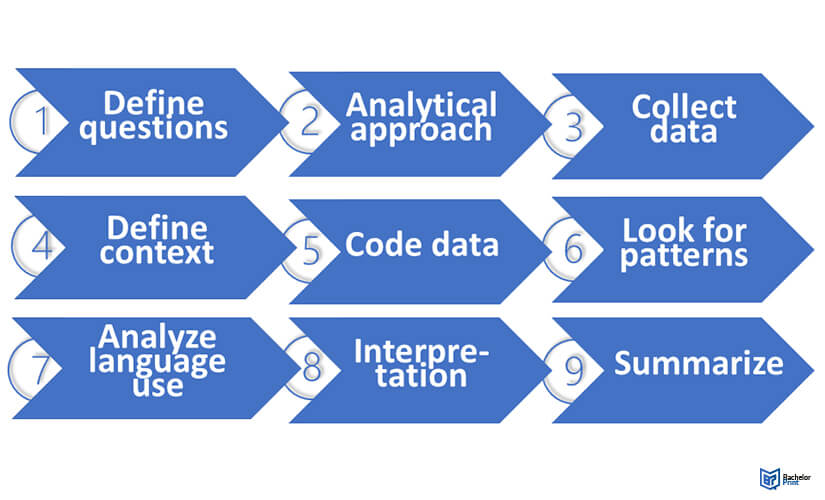
Discourse analysis utilizes a unique methodology designed to reveal the underlying significance of both written and spoken language. This methodology is often a focal point of study in higher education courses related to humanities, linguistics, or social sciences.
In this piece, we will delve into the specific applications and nuances of discourse analysis, providing a detailed, step-by-step guide to assist you in incorporating this methodology into your scholarly work.
Definition: Discourse analysis
Discourse analysis, which is sometimes abbreviated as DA, is a set of research methodologies created to uncover deep layers of meaning in different forms of speech, whether they are written or spoken.
As a research method, discourse analysis does not simply analyze language. Instead, it’s a tool that can reveal how language is used to express meaning and/or to achieve specific communicative goals.
You can apply different methods and perspectives to discourse analysis.
What is discourse analysis used for?
In academia, discourse analysis plays an important role in helping reveal nuances that can be very valuable in qualitative research. As such, it is commonly used by students of history, politics, sociology, linguistics, or gender studies to analyze past or current examples of discourse and to draw conclusions about the links between language and society.
As a student, you would want to use discourse analysis methodologies to reach a deeper level of analysis that can have a positive impact on your grades.
Discourse analysis vs. other methods
Discourse analysis is not the only methodology that studies language. However, it substantially differs from other methods, like grammar analysis. While the latter is concerned with grammatical or syntactical structure, discourse analysis helps the researcher or student dig deep under such structures to find meaningful insights.
Another difference is that language-focused analysis techniques tend to study language components in isolation, whereas discourse analysis takes those elements and evaluates them considering the context in which they happen.
In addition, discourse analysis examines authentic forms of language as they occur in real life, while researchers or students using other methods are more likely to create their own samples and examples.
Discourse analysis: Step-by-step

1. Define your primary questions
If you’re using discourse analysis as a research tool, you’ll want to frame your research with one or two relevant research questions. This will help you stay on topic and bring coherence to your work.
2. Choose your analytical approach
Next, you want to choose an analytical approach that will help shape and guide your discourse assessment. Which approach you choose will depend on your course and degree subject. For example, if you’re studying anthropology, you could choose to interpret your discourse analysis findings based on postmodernist theory. Or if you’re studying media and communication, you could choose a semiotic approach.
3. Collect your data
This is where you gather your research materials, which can be written texts, conversation transcripts, videos, speeches, debates, etc.
4. Define the context
Be as specific as you can about the context in which the discourse takes place. Here you can consider social, political, historical, or geographical data. Then, you can start making hypotheses as to how context influences discourse, and vice versa.
5. Code your data
Coding means systematically tagging research data, based on meaningful categories. For example, if you were analyzing a political speech, you could create various data categories based on the themes that keep appearing throughout the speech (e.g. democracy, community, identity), then you would find all statements relevant to each theme.
Also, make sure the themes are related to your research question/s.
6. Look for patterns
Go over your coded materials and try to find recurring patterns. Are certain words, sentences, or ideas repeated? If you’re analyzing conversations, does one person dominate the interaction? Are there silences or pauses?
7. Analyze language use
Here, you go into detail about the various aspects of language use, such as metaphors, jargon, use of active and passive voice, use of persuasive statements, etc.
8. Interpret your findings
Keeping your research data and analytical framework in mind, try to uncover the meaning of the discourse you’re analyzing, always relative to your research question/s. Make sure you present evidence in support of your interpretation.
9. Summarize your findings
You can close a discourse analysis exercise with a summary of your findings and suggest areas for potential future research.
Discourse analysis: Advantages vs. disadvantages
| ✓ Advantages | ✗ Disadvantages |
| It’s a flexible methodology that can account for social and linguistic changes. | Interpretation is subjective. |
| It can reveal insights that lie beyond the scope of quantitative research methods. | There’s no unified framework for interpretation. |
| It takes into account context, which can help gain a higher perspective on a topic. | Because analysis and interpretation are done manually, it can be very time-consuming. |
FAQs
In academic settings, there are four main types of discourse analysis:
- Descriptive
- Focuses on analyzing how language is used to describe the characteristics of people, objects, concepts, or events.
- Narrative
- Attempts to uncover the underlying story behind a text, speech, or communicative interaction.
- Argumentative
- Explores how language is used to tilt the audience in favor or against a topic or issue.
- Expository
- Examines language-in-use and how it conveys information.
Not exclusively. In some cases, discourse analysis methodologies analyze non-verbal factors (such as body language or intonation) in order to reveal the rich meaning behind communicative acts.
The context in which discourse takes place, as well as the patterns and themes that emerge from language use.
Yes, it is also used by political analysts, in social policy, and in marketing research.
